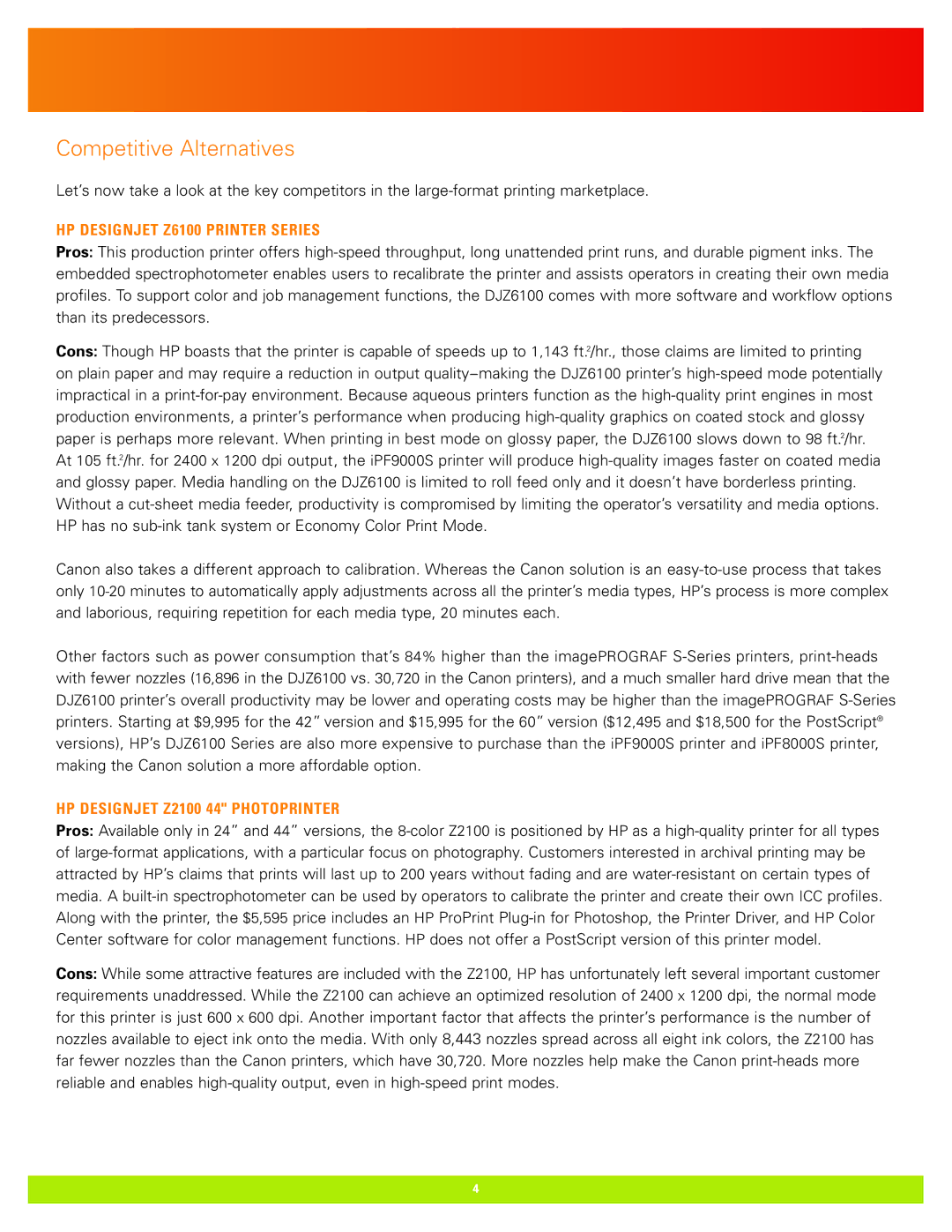Competitive Alternatives
Let’s now take a look at the key competitors in the large-format printing marketplace.
HP DESIGNJET Z6100 PRINTER SERIES
Pros: This production printer offers high-speed throughput, long unattended print runs, and durable pigment inks. The embedded spectrophotometer enables users to recalibrate the printer and assists operators in creating their own media profiles. To support color and job management functions, the DJZ6100 comes with more software and workflow options than its predecessors.
Cons: Though HP boasts that the printer is capable of speeds up to 1,143 ft.2/hr., those claims are limited to printing on plain paper and may require a reduction in output quality–making the DJZ6100 printer’s high-speed mode potentially impractical in a print-for-pay environment. Because aqueous printers function as the high-quality print engines in most production environments, a printer’s performance when producing high-quality graphics on coated stock and glossy paper is perhaps more relevant. When printing in best mode on glossy paper, the DJZ6100 slows down to 98 ft.2/hr. At 105 ft.2/hr. for 2400 x 1200 dpi output, the iPF9000S printer will produce high-quality images faster on coated media and glossy paper. Media handling on the DJZ6100 is limited to roll feed only and it doesn’t have borderless printing. Without a cut-sheet media feeder, productivity is compromised by limiting the operator’s versatility and media options. HP has no sub-ink tank system or Economy Color Print Mode.
Canon also takes a different approach to calibration. Whereas the Canon solution is an easy-to-use process that takes only 10-20 minutes to automatically apply adjustments across all the printer’s media types, HP’s process is more complex and laborious, requiring repetition for each media type, 20 minutes each.
Other factors such as power consumption that’s 84% higher than the imagePROGRAF S-Series printers, print-heads with fewer nozzles (16,896 in the DJZ6100 vs. 30,720 in the Canon printers), and a much smaller hard drive mean that the DJZ6100 printer’s overall productivity may be lower and operating costs may be higher than the imagePROGRAF S-Series printers. Starting at $9,995 for the 42” version and $15,995 for the 60” version ($12,495 and $18,500 for the PostScript® versions), HP’s DJZ6100 Series are also more expensive to purchase than the iPF9000S printer and iPF8000S printer, making the Canon solution a more affordable option.
HP DESIGNJET Z2100 44" PHOTOPRINTER
Pros: Available only in 24” and 44” versions, the 8-color Z2100 is positioned by HP as a high-quality printer for all types of large-format applications, with a particular focus on photography. Customers interested in archival printing may be attracted by HP’s claims that prints will last up to 200 years without fading and are water-resistant on certain types of media. A built-in spectrophotometer can be used by operators to calibrate the printer and create their own ICC profiles. Along with the printer, the $5,595 price includes an HP ProPrint Plug-in for Photoshop, the Printer Driver, and HP Color Center software for color management functions. HP does not offer a PostScript version of this printer model.
Cons: While some attractive features are included with the Z2100, HP has unfortunately left several important customer requirements unaddressed. While the Z2100 can achieve an optimized resolution of 2400 x 1200 dpi, the normal mode for this printer is just 600 x 600 dpi. Another important factor that affects the printer’s performance is the number of nozzles available to eject ink onto the media. With only 8,443 nozzles spread across all eight ink colors, the Z2100 has far fewer nozzles than the Canon printers, which have 30,720. More nozzles help make the Canon print-heads more reliable and enables high-quality output, even in high-speed print modes.

